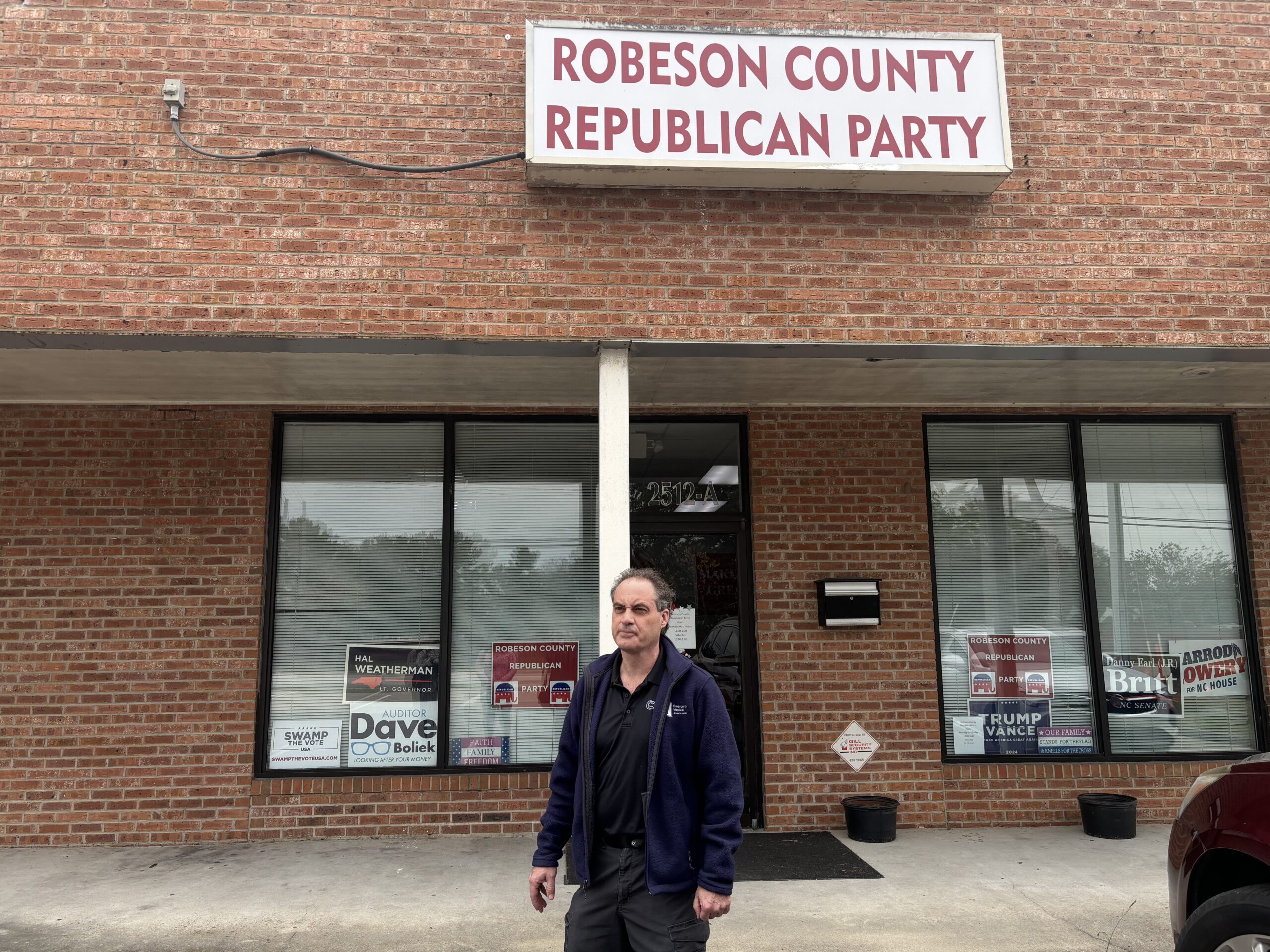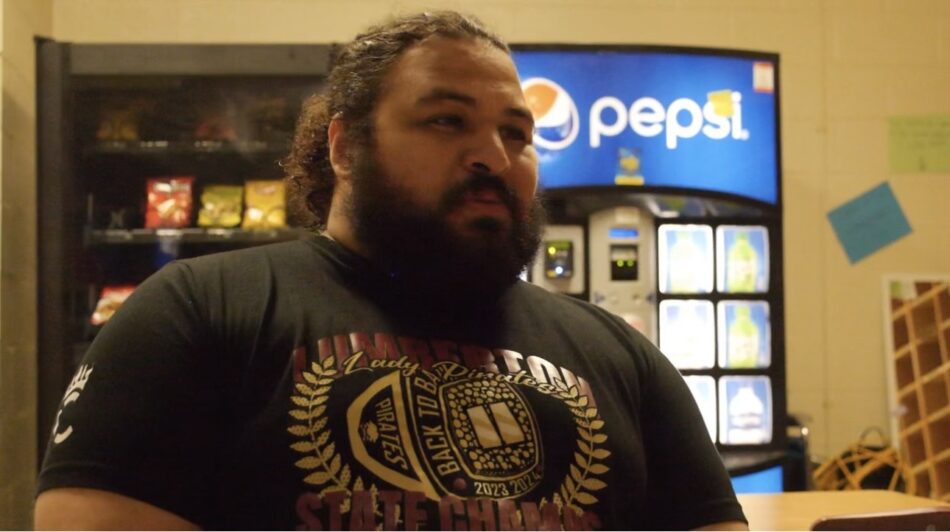In the teacher’s lounge of Lumberton High School in Lumberton, NC, surrounded by motivational posters and teaching supplies, James Bell, a world history teacher, passionately expressed the importance of his role.
“These kids have never been outside of the county,” said Bell, “So you kind of have to explain everything, basically how the world works. ‘How do you take all this information that could potentially be thrown at you, and how do I use my critical thinking in reading comprehension to not get fooled by somebody?’”
Bell, 31, is a Democrat and a Lumbee man. He teaches ninth grade world history and coaches wrestling at Lumberton High, his alma mater. In Robeson County, schools like Lumberton High constantly battle underfunding. This puts a strain on teachers like Bell.
According to the Public School Forum of North Carolina, $656 is spent per public school student in Robeson County — ranking it 99th out of the state’s 100 counties.
When speaking about the impact that politicians have on education, Bell said he voted for Vice President Kamala Harris because he felt that the Democrats were more equipped than republicans to handle the public education system.
“If I’m talking about what I’m voting for, I’m not voting for that, because that goes against my own self-interest, not even self-interest. It goes against my job,” said Bell.
Since Harris lost the presidential race, the Department of Education is at the hands of Donald J. Trump.
Trump has not explicitly outlined his plans for public education. He has alluded to some drastic changes that he would like to make once he is in office. He has indicated intentions to dismantle the U.S. Department of Education, ban schools from teaching Critical Race Theory and promote school choice — policies for parents to use public funds for things like private education.
Bell emphasized his frustration with school choice. He stated that he doesn’t want public funds going to private schools.
“If you want to be a private school, find whatever rich benefactor or patron you want,” he said. “Get all your money from that guy. Don’t take it away from taxpayers.”
In North Carolina, private school vouchers, known as Opportunity Scholarships, provide families with funding of up to $7,000 per year for private education. The North Carolina General Assembly has removed the income cap for these vouchers, allowing families of all income levels to access them.
In the 2022–-23 school year, 461 students were enrolled in public schools. 425 students obtained Opportunity Scholarships, according to the North Carolina Department of Administration.
Some skeptics argue that Opportunity Scholarships divert resources away from public education.
According to a study by the North Carolina Office of State Budget and Management, the vouchers could result in a loss of over $203 million in public education funding, potentially leading to the loss of around 26,500 public school students in the state.
Bell said he felt that the Republican Party is promoting agendas like school choice to harm the public school system.
“Republicans are trying to destroy public education on purpose, so then they can say public schools are bad,” said Bell. “They want to take all the public education money and put it into charter schools. That’s just segregation 2.0.”

Robeson County Republican Party Chairman Phillip Stephens standing outside of headquarters. (Photo by Chloe-Ryan Woolfolk.)
Five minutes down the road, at the Robeson County Republican Party Headquarters, stood Phillip Stephens, a 61-year-old physician’s assistant who has chaired the Robeson County Republicans Party since 2008.
“I tell folks it’s no huge difference. I know it sounds crazy, but it was a big switch from Democrat to Republican here, because we were conservative Democrats, and that’s what this area, pretty much is,” said Stephens.
Before becoming a Republican in 2000, Stephens was a Democratic operative. Previously, Stephens said there was no real divide between Democrats and Republicans because they shared similar values.
Now, people like Stephens and Bell represent two opposing ends of the political spectrum.
Stephens said that school choice provides opportunities for both families and underperforming schools.
“If your child does not feel like he’s getting education where he’s at, well, take your money and you can move him to a school that’s higher performing,” said Stephens. “What that does is the flip side of that coin. It forces those poor schools to make sure that they perform so they don’t lose that money.”
When speaking about Critical Race Theory — a framework created by legal scholars who determined racism was a systemic issue — Stephens says that the framework is too complex for children to learn.
“It’s difficult for us to get our brains wrapped around the controversy regarding all this stuff,” said Stephens. “Let’s talk about those graduate issues when they’re mature enough to talk about those issues. We would like to get the basics, reading, writing, math, together when they’re younger.”
“So, when you talk about getting rid of the department of education at the federal level, he’s not talking about getting rid of control of education. What he’s talking about is putting it back out into the communities.”Although Trump has tried to distance himself from The Heritage Foundation’s “Mandate for Leadership,” also known as Project 2025, a document including plans that would drastically affect the public education system.
According to the foundation’s website, their mission is “to formulate and promote public policies based on the principles of free enterprise, limited government, individual freedom, traditional American values, and a strong national defense.”
The nearly 1,000-page manifesto — cosigned by former Trump appointees — outlines plans to restructure the United States government and align it with conservative policies once Donald Trump takes office in 2025.
The document proposes censoring discussions of race and gender in classrooms, eliminating Title I funding, providing private school vouchers in every state and dismantling the Department of Education.
Despite the district’s current limited funding, Bell said that the school receives grants for technology, allocated to low-income schools. Technology, he added, can be used to communicate with students who speak English as a second language and to combat a lack of textbooks, but it presents challenges in other ways.
“You can tell whether kids have technology or not at home,” said Bell. “How well they can use some of these devices, or how to use it in a way that’s truly beneficial for them.”
According to a 2020 Pew Research Center study, 59% of U.S. parents with lower incomes said that their child faced digital obstacles in their schoolwork.
“Sometimes that means someone’s going to get neglected in some way, shape or form,” said Bell.
Bell added that the use of technology posed an issue when he tries to motivate his students to retain information and value education.
“How do you think about the world when you have all the information that’s ever been created in the palm of your hand?” he asked. “How much do you really have to remember when you can just use the technology?”
“It’s more about trying to get kids working towards valuing this education right and valuing a post-secondary education or trade school or community college.”
He attributed poverty to students’ lack of education.
Robeson County is one of the poorest counties in the state. Its poverty rate sits at 26.1%, well above the national average of 11.1%, according to the U.S. Census Bureau.
“Lacking resources in your life can affect how you learn overall,” said Bell. “In some cases, the school is the only thing that’s really pushing education for some of these kids.”
On Nov. 5, Trump won more than 63% of the vote in Robeson County. Since the election, there has been no confirmation from the Trump administration about their plans for public education.
However, Bell displayed optimism when he thought about the students at Lumberton High School.
“The obviously low funding, or the lack of funds or whatever it is can slow that progress down,” said Bell. “But progress is still coming.”

